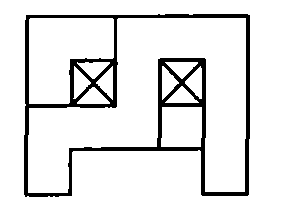Transverse flux permanent-magnet planar motor
A technology of permanent magnet plane and transverse magnetic flux, applied in the direction of electrical components, electromechanical devices, electric components, etc., can solve the problems of low current control accuracy, limited mover stroke, complex motor structure, etc., and achieve improved current and electromagnetic force control High precision, high thrust density and power density, and the effect of eliminating mutual inductance between phases
- Summary
- Abstract
- Description
- Claims
- Application Information
AI Technical Summary
Problems solved by technology
Method used
Image
Examples
specific Embodiment approach 1
[0009] Specific implementation mode 1. Combination figure 1 and figure 2 Describe this embodiment, this embodiment is made up of primary and secondary; secondary is made up of permanent magnet array; primary is made up of several motor units, each motor unit is made up of m 2 Composed of phase armature units 1, m 2 A phase armature unit 1 forms a phase armature unit array 2 of m rows and m columns, and the row spacing of the phase armature unit array 2 is equal to the column spacing; each phase armature unit 1 is composed of a phase unit core 3 and the phase unit winding 4; each phase unit core 3 is composed of two core units 5 and has a tooth hole 71, and the tooth hole 71 is formed by overlapping the tooth slots 72 of the two core units 5, Each core unit 5 is made up of two teeth and a yoke segment; the two teeth are arranged along the horizontal direction of the cross section, and a yoke segment is connected between the two teeth; the two core units 5 are arranged along...
specific Embodiment approach 2
[0010] Specific embodiment two, combine Figure 3 to Figure 7 Describe this embodiment. The first difference between this embodiment and the specific embodiment is that each core unit 5 in the phase unit core 3 is composed of a long tooth 51, a short tooth 52, a high-level yoke segment 53, a low The horizontal yoke section 54 and a vertical yoke section 55 are composed; the long teeth 51 and the short teeth 52 are arranged along the horizontal direction of the cross section, and the long teeth 51 and the short teeth 52 are sequentially connected with high The horizontal yoke section 53, the vertical yoke section 55 and the low horizontal yoke section 54, the side root of the long tooth 51 is connected to the side of one end of the high horizontal yoke section 53, and the high horizontal yoke The other side of the section 53 is connected to the root of one side of the vertical yoke section 55, and the other side of the vertical yoke section 55 is connected to one end of the low...
specific Embodiment approach 3
[0011] Specific embodiment three, combine Figure 3 to Figure 5 This embodiment is described. The difference between this embodiment and the second embodiment is that the coil 41 is circularly wound on the upper part of the long tooth 51 or on the high horizontal yoke segment 53 or the vertical yoke segment 55 through the two tooth holes 7 described above. Phase-to-phase unit windings. Other compositions and connection methods are the same as those in the second embodiment.
PUM
 Login to View More
Login to View More Abstract
Description
Claims
Application Information
 Login to View More
Login to View More - R&D
- Intellectual Property
- Life Sciences
- Materials
- Tech Scout
- Unparalleled Data Quality
- Higher Quality Content
- 60% Fewer Hallucinations
Browse by: Latest US Patents, China's latest patents, Technical Efficacy Thesaurus, Application Domain, Technology Topic, Popular Technical Reports.
© 2025 PatSnap. All rights reserved.Legal|Privacy policy|Modern Slavery Act Transparency Statement|Sitemap|About US| Contact US: help@patsnap.com



